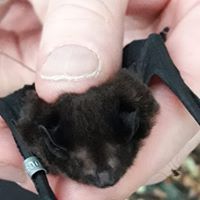
The Conservation Company of Central Hawke’s Bay along with DOC and local volunteers have embarked on an exciting new project, identifying roost sites of the endangered New Zealand native pekapeka [long-tailed bat] across the Ashley Clinton and Tikokino areas.
Bat numbers nationally were thought to be stable, but due to predators [cats, rats, stoats and possums] combined with a loss of their natural habitat of old trees and lowland forests, there has been a recent threat status increase to Nationally Critical, the highest ranking. This means without management there is a high likelihood of extinction of this native bat.
Project co-ordinator, Kay Griffiths, is so excited to see this project get underway after years of dreaming about it. “I remember working for DOC in the early 1990’s and being aware of the bats in the A’Deanes Bush, Inglis Bush and Monckton Reserve area, but we have never known where they roost. With the threat status increase I feel it is timely to undertake some formal research and gather information and identify roost sites so going forward we will be in a position to actively protect these bats from predators”.
The project, known as “Ngā Pekapeka o Ngā Motu Rākau o Ruataniwha” commenced in early December and continues through January. Two experienced bat experts are assisting with the catching, banding and monitoring of the bats.
The teams of experts and volunteers are working in two shifts, the first working from about 6pm until midnight set up the traps and watch roost trees. They also follow bats with telemetry equipment to establish foraging patterns.
The second shift work from 4.30-10.30am and are also responsible for following the bats to their daytime roosting sites.
The bats are very small, weighing only about 12 grams. They are chestnut brown in colour and are thought to only have one offspring annually. The bats can fly quickly, at up to 60 km per hour and they feed on flying insects like moths, mosquitoes and beetles.
The project would not have got off the ground without the funding support of the DOC Community Fund, the Hawke’s Bay Regional Council and the WWF Community Conservation fund. The grants are being held and managed by Biodiversity Hawke’s Bay who are tasked with putting the Hawke’s Bay Biodiversity Strategy into action – a strategy that DOC is a partner in. Kay is also indebted to the local DOC staff who have lent her equipment and given advice.
Photo: Example of harp traps being used for the project.
5 February 2020
Disclaimers and Copyright
While every endeavour has been taken by the Hawke's Bay Regional Council to ensure that the information on this website is
accurate and up to date, Hawke's Bay Regional Council shall not be liable for any loss suffered through the use, directly or indirectly, of information on this website. Information contained has been assembled in good faith.
Some of the information available in this site is from the New Zealand Public domain and supplied by relevant
government agencies. Hawke's Bay Regional Council cannot accept any liability for its accuracy or content.
Portions of the information and material on this site, including data, pages, documents, online
graphics and images are protected by copyright, unless specifically notified to the contrary. Externally sourced
information or material is copyright to the respective provider.
© Hawke's Bay Regional Council - www.biodiversityhb.org / 027 231 9367 / info@biodiversityhb.nz